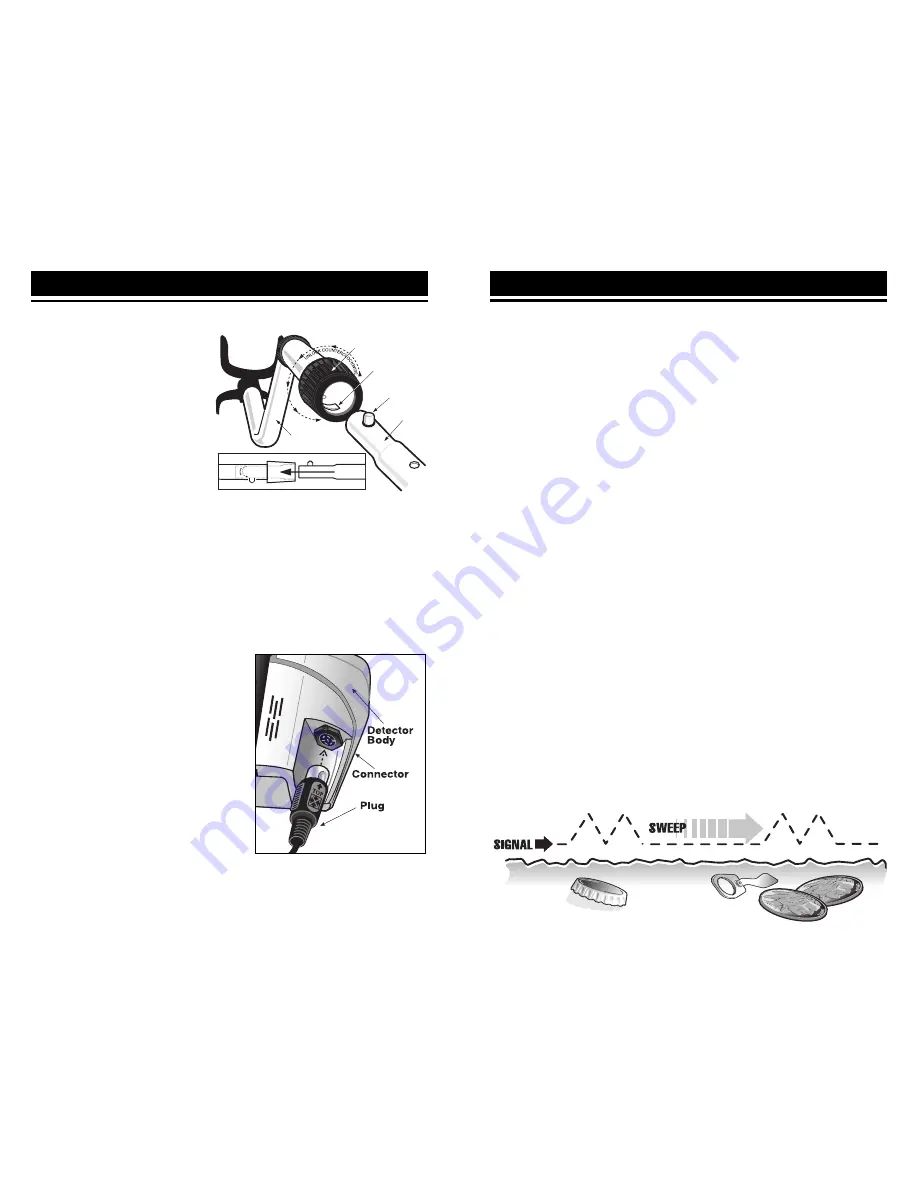
Swing the searchcoil slowly,
overlapping each sweep as you
move forward. It is important to
sweep the coil at a consistent speed
over the ground as you search. After
identifying a target, your sweep
technique can help in identifying both
the location and the nature of the
target. If you encounter a weak
signal, try moving the coil in short,
rapid sweeps over the target zone;
such a short rapid sweep may
provide a more consistent target
identification.
Most worthwhile objects will
respond with a repeatable tone. If
the signal does not repeat after
sweeping the coil directly over the
suspected target a few times, it is
more than likely trash metal.
Crossing the target zone with
multiple intersecting sweeps at
multiple angles is another way to
verify the repeatability of the signal,
and the potential of the buried target.
To use this method, walk around the
target area in a circle, sweeping the
coil across the target repeatedly,
every 30 to 40 degrees of the circle,
about ten different angles as you
walk completely around the target. If
a high-tone target completely
disappears from detection at a given
angle, chances are that you are
detecting oxidized ferrous metals,
rather than a silver or copper object.
If the tone changes at different
angles, you may have encountered
multiple objects. If you are new to
the hobby, you may want to dig all
targets at first. With practice in the
field, you will learn to better discern
the nature of buried objects by the
nature of the detector’s response.
You may encounter some false
signals as you proceed. False signals
occur when the detector beeps, but
no metal target is present. False
signals can be induced by
electromagnetic interference,
oxidation, or highly mineralized
ground soils. If the detector beeps
once, but does not repeat the signal
with several additional sweeps over
the same spot, there is probably no
target present.
When searching very trashy ground,
it is best to scan small areas with
slow, short sweeps. You will be
surprised just how much trash metal
and foil you will find in some areas.
The trashiest areas have been
frequented by the most people, and
frequently hold the most promise for
finding the most lost valuables.
Also maintain the searchcoil
positioned just above the surface of
the ground, without making contact
with the ground. Making contact with
the ground can cause false signals.
WHAT
READS
LIKE THIS
…MAY
ACTUALLY
BE THIS
4
Assembly
17
In The Field Techniques(continued)
Assembly is easy and requires no tools.
●
1
Position detector upright.
●
2
Rotate the LOCKING
COLLAR fully in a counter
clockwise direction.
●
3
Insert your finger inside the
tube and make sure the
INTERNAL CAM LOCK is
flush with the inside of the
tube.
●
4
Insert the LOWER STEM into
the S-ROD.
●
5
Rotate the LOWER STEM until the SILVER BUTTON locates in the hole.
●
6
Twist the LOCKING COLLAR fully in the clockwise direction until it locks.
●
7
If your detector has 3 tubes and 2 locking collars, repeat this process
on the Middle Stem.
●
8
Position the Lower Stem (the straight tube) with the Silver Button
toward the back. Using the Bolt and Knurled Knob, attach the
Searchcoil to the plastic extension protruding from the Lower Stem.
●
9
Press the button on the upper end of the Lower Stem, and slide the
Lower Stem into the S-Rod.
Adjust the Stem to a length that lets
you maintain a comfortable upright
posture, with your arm relaxed at
your side, and the Searchcoil
parallel to the ground in front of
you.
●
10
Wind the Cable securely around
the Stem.
●
11
Insert the Plug into the matching
Connector on the right underside
of the Detector Body. Be sure that
the key-way and pins line up
correctly.
Caution:
Do not force the plug in. Excess force will cause damage.
To disconnect the cable, pull on the plug.
Do not pull on the cable.
S-ROD
LOCKING
COLLAR
INTERNAL
CAM LOCK
SILVER BUTTON
MIDDLE
STEM
S-ROD
MIDDLE STEM
























